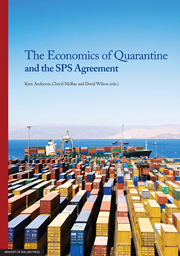Book contents
- Frontmatter
- Contents
- List of tables, figures and boxes
- Acronyms
- Preface
- List of contributors
- 1 Introduction
- PART I The multilateral rules under WTO
- PART II The ‘appropriate level of protection’
- PART III Adding more economics to risk analysis
- 11 Least trade-restrictive SPS policies: an analytic framework is there but questions remain
- 12 Quarantine decision making in Australia
- 13 Quarantine reform: Australia's recent experience
- 14 Evaluating economic consequences of livestock diseases: a US perspective
- PART IV Specific health and environmental risks from trade
- PART V Conclusion
- APPENDIX The legal text of the SPS Agreement
13 - Quarantine reform: Australia's recent experience
from PART III - Adding more economics to risk analysis
Published online by Cambridge University Press: 05 June 2013
- Frontmatter
- Contents
- List of tables, figures and boxes
- Acronyms
- Preface
- List of contributors
- 1 Introduction
- PART I The multilateral rules under WTO
- PART II The ‘appropriate level of protection’
- PART III Adding more economics to risk analysis
- 11 Least trade-restrictive SPS policies: an analytic framework is there but questions remain
- 12 Quarantine decision making in Australia
- 13 Quarantine reform: Australia's recent experience
- 14 Evaluating economic consequences of livestock diseases: a US perspective
- PART IV Specific health and environmental risks from trade
- PART V Conclusion
- APPENDIX The legal text of the SPS Agreement
Summary
Three years after the Australian government announced major changes to Australia's quarantine system, quarantine-related issues continue to elicit strong interest from the media, some industries and foreign governments, and quarantine remains high on the policy agenda. It is therefore time to ask: what have been the major outcomes of reforming the Australian quarantine system and what now are the key issues from an economic perspective?
This chapter addresses these questions by first briefly reviewing the background to and major tenets of the report of the Australian Quarantine Review Committee (Nairn et al. 1996) which formed the basis for the government's fundamental reforms to the quarantine system announced in August 1997 (DPIE 1997). The chapter examines the broad outcomes resulting from the government's reforms before focusing on the key issues of managed risk (in particular, import risk analysis) and the continuum of quarantine (that is, expanding the scope of quarantine to include pre-border, border and post-border activities that assist in achieving the quarantine objective). Finally some comments are made about the performance of quarantine delivery and the goal of quarantine from an economic perspective.
Australian quarantine reform
The efficacy of the Australian Quarantine and Inspection Service (AQIS) – the organisation responsible for the development of Australia's quarantine policy and programs – was called into question in the early 1990s by the entry into Australia of a succession of exotic pests and diseases that attracted wide media attention1. Concern about the adequacy of Australia's quarantine system was exacerbated by a highly politicised and public debate concerning the entry conditions for a number of products on which AQIS and industry representatives were unable to reach common ground for deciding issues on their scientific merit. As Nairn et al. (1996, p.3) observed, the debate was ‘resource-intensive and time-consuming’ and led to ‘community concern about Australia’s quarantine services'.
- Type
- Chapter
- Information
- The Economics of Quarantine and the SPS Agreement , pp. 240 - 264Publisher: The University of Adelaide PressPrint publication year: 2012

